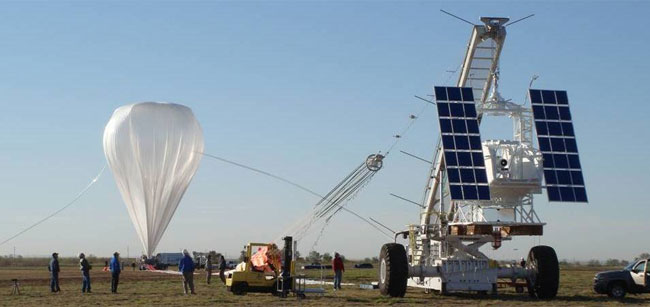Giant Balloon to Launch Sun-Watching Telescope

A telescopelashed to a giant balloon is poised to lift off from Sweden as early as Mondayto study the surface of the sun.
DubbedSunrise, the balloon observatory should stay aloft for nearly a week as ittravels from the Esrange Space Center in Sweden over the arctic to a safetouchdown in Canada. The mission is part of a NASA experiment for balloonlaunches and is slated to fly up to six days to snap high-resolutionphotographs of the sun's surface.
The telescopeand its gondola of scientific instruments are a 2-ton payload that will beborne under a balloon that is larger than a sports arena, filled with nearly 34million cubic feet of helium. It should cross the arctic at an altitude ofnearly 23 miles (37 km). To track the sun while it floats above Earth, thegondola has a pointing system that allows it to rotate horizontally.
ThroughSunrise, scientists seek to demystify some of the fascinating and destructivephenomena caused by magnetic fields on the sun's surface. Those fields canbe associated with sunspots and explosive coronal mass ejections which lead tospace weather events that can affect the climate here on Earth. Space weather,like energeticsolar flares and solar winds, can damage satellites in Earth's orbit,endanger astronauts and even disrupt power grids on the ground.
Sunriseproject managers plan to launch the solar telescope on June 1, but could trythroughout early July to await pristine weather conditions.
Sunrise ispart of a NASA experiment with balloon-launched research projects, this one inconjunction with scientists and agencies from Germany, Spain and the UnitedStates. Using balloons, NASA seeks to cut the cost of launching orbitalsatellites. While Sunrise is estimated to cost $60 million to $80 million, thecost of launching a similar-sized telescope into orbit might run as high as$500 million, Michael Knolker, director of National Center for AtmosphericResearch's High Altitude Observatory in Boulder, Colo., told SPACE.com lastyear.
This is thegondola's second launch after a successful test-run over the ColumbiaScientific Balloon Facility in Fort Sumner, New Mexico, in 2007. Inthat test, the balloon launched without the telescope.
Breaking space news, the latest updates on rocket launches, skywatching events and more!
- Image Gallery - Sun Storms
- Video - Sun Storms: Havoc on Our Electronic World
- Plan to Send Hot Air Balloon to Saturn's Moon Titan

Space.com is the premier source of space exploration, innovation and astronomy news, chronicling (and celebrating) humanity's ongoing expansion across the final frontier. Originally founded in 1999, Space.com is, and always has been, the passion of writers and editors who are space fans and also trained journalists. Our current news team consists of Editor-in-Chief Tariq Malik; Editor Hanneke Weitering, Senior Space Writer Mike Wall; Senior Writer Meghan Bartels; Senior Writer Chelsea Gohd, Senior Writer Tereza Pultarova and Staff Writer Alexander Cox, focusing on e-commerce. Senior Producer Steve Spaleta oversees our space videos, with Diana Whitcroft as our Social Media Editor.
